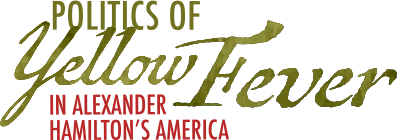About the Module
Author: Ashley Bowen, PhD is a guest curator and collections researcher at the U.S. National Library of Medicine. Her research focuses on nineteenth century public health and medicine, the material culture of medicine, and representations of patient experience. She served as a Brown-Wheaton Faculty Fellow and held a pre-doctoral fellowship at the Smithsonian Institution’s National Museum of American History. Her scholarship has also been supported by the F. C. Wood Institute for the History of Medicine at the College of Physicians Philadelphia.
Suggested Use: The “Factions, Parties, and Yellow Fever” module is a companion to the website and exhibition Politics of Yellow Fever in Alexander Hamilton’s America. This module, for use in colleges and university courses, encourages students to examine in detail how different groups in Philadelphia responded to a deadly epidemic in 1793. It offers students the opportunity to discuss how, in climates defined by uncertainty and fear, highly charged party politics, and social divisions based on race and class provided people with a way to manage their anxiety and evaluate information.
Instructors can use this module to introduce students to America’s first party system, intellectual history, the history of science and medicine, and ideas about race in the Early Republic. Each class, designed for flexible use in 50 to 90-minute class periods, includes a short introduction, primary and secondary sources, and discussion questions. The sources range from recent scholarly works in the history of medicine to primary sources written by important historical figures to visual materials like portraits and early political cartoons. The readings, visual materials, overviews, and questions in this lesson plan will challenge students to think about the dynamic relationship between epidemic disease, politics, and social identities. This module is appropriate for college or university courses ranging from introductory US history surveys to courses on the history of science and/or medicine, political history, public health, political science, and African American or Africana studies.
In addition to the readings assigned in each class module, instructors may find the following books, journal articles, and podcasts useful in their preparation:
Covart, Liz. Thomas Apel, Yellow Fever in the Early American Republic. MP3. Ben Franklin’s World. Accessed February 20, 2018. Available online: https://www.benfranklinsworld.com/episode-174-thomas-apel-yellow-fever-early-american-republic/.
Eisenberg, Leon. “Furor Therapeuticus: Benjamin Rush and the Philadelphia Yellow Fever Epidemic of 1793.” The American Journal of Psychiatry 164, no. 4 (April 2007): 552–55.
Finger, Simon. The Contagious City: The Politics of Public Health in Early Philadelphia. Ithaca: Cornell University Press, 2012.
Kilbane, John Michael. “Death from Above, 1793: A Plague of Yellow Fever Strikes the Nation’s Largest City and Newest Capital, Philadelphia.” Roundtable (blog), Lapham’s Quarterly, December 17, 2013. https://www.laphamsquarterly.org/roundtable/death-above-1793.
Kopperman, Paul E. “‘Venerate the Lancet’: Benjamin Rush’s Yellow Fever Therapy in Context.” Bulletin of the History of Medicine 78, no. 3 (Fall 2004): 539–74.
Sullivan, R. B. “Sanguine Practices: A Historical and Historiographic Reconsideration of Heroic Therapy in the Age of Rush.” Bulletin of the History of Medicine 68, no. 2 (1994): 211–34.
Taylor, S. “Yellow Fever: Politics and Class Relations in Philadelphia, 1793–1805.” Transactions & Studies of the College of Physicians of Philadelphia 21 (December 1999): 55–58.
Tighe, Janet Ann. “Negotiating the Health of the Public: Yellow Fever in 1793 Philadelphia.” OAH Magazine of History 19, no. 5 (September 2005): 30–35.
Academic Goals: After completing a unit or the entire module, students will be able to
- Analyze primary and secondary sources
- Evaluate multiple, opposing points of view on a single topic
- Explain the competing scientific understandings of yellow fever’s origins
- Discuss the dynamic between epidemic disease and political ideology
- Describe how social factors shaped a person⁏s experience of the epidemic






